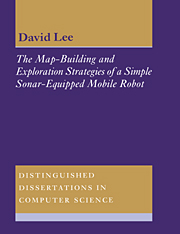 The Map-Building and Exploration Strategies of a Simple Sonar-Equipped Mobile Robot
The Map-Building and Exploration Strategies of a Simple Sonar-Equipped Mobile Robot Published online by Cambridge University Press: 05 March 2012
This thesis has described an investigation into the complementary problems of map-building and exploration by a mobile robot. This chapter highlights the most significant results of this investigation.
The novel contribution of this research can be summarised as:
• The integration of a physical robot, a sonar model, map construction algorithms, and a localisation algorithm into an effective working system;
• The definition and implementation of a novel quantitative measure of map quality;
• A thorough quantitative and statistical evaluation of the map-building and exploration capabilities of the system, using the quality metric and a variety of exploration strategies.
The system components and the quality metric were described in Part II of this thesis. Sections 19.1 to 19.4 briefly review these topics. The experimental evaluation of exploration strategies formed the bulk of Part III of this thesis. The results of this work have already been summarised in Chapter 18.
Chapter 2 described the continuing debate between the ‘traditional’ supporters of modelbased robotics and the proponents of behaviour-based robotics. An outcome of the current research has been an awareness of the need to balance these two approaches. The value of reactive navigation became more apparent as the research progressed. Section 19.5 reviews the course of the research in the context of the ‘models versus behaviours’ debate.
19.1 The Ultrasonic Sensor Model
Chapter 6 presented a set of experimental results which showed how the Polaroid ultrasonic rangefmder detected each type of object that would be encountered in the test environments.
To save this book to your Kindle, first ensure [email protected] is added to your Approved Personal Document E-mail List under your Personal Document Settings on the Manage Your Content and Devices page of your Amazon account. Then enter the ‘name’ part of your Kindle email address below. Find out more about saving to your Kindle.
Note you can select to save to either the @free.kindle.com or @kindle.com variations. ‘@free.kindle.com’ emails are free but can only be saved to your device when it is connected to wi-fi. ‘@kindle.com’ emails can be delivered even when you are not connected to wi-fi, but note that service fees apply.
Find out more about the Kindle Personal Document Service.
To save content items to your account, please confirm that you agree to abide by our usage policies. If this is the first time you use this feature, you will be asked to authorise Cambridge Core to connect with your account. Find out more about saving content to Dropbox.
To save content items to your account, please confirm that you agree to abide by our usage policies. If this is the first time you use this feature, you will be asked to authorise Cambridge Core to connect with your account. Find out more about saving content to Google Drive.